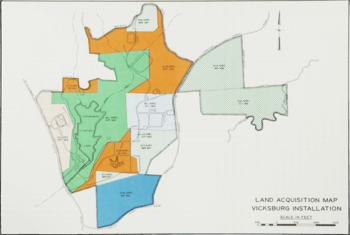Waterways Experiment Station facts for kids
The Waterways Experiment Station, or WES, is a large research center in Vicksburg, Mississippi. It was built in 1930 by the United States Army Corps of Engineers. This place is like a huge science lab, covering about 673 acres. It's where the main office for the Engineer Research and Development Center (ERDC) is located. WES is the biggest of the four research labs run by the Corps of Engineers.
In 2000, WES was added to the U.S. National Register of Historic Places. This was partly because of its unique buildings. The historic area covers about 16 acres. It includes five important buildings and three other structures.
Quick facts for kids |
|
|
Waterways Experiment Station
|
|

Entrance to WES (1968).
|
|
| Location | Roughly bounded by Spillway, Durden Creek, Tennessee Rd., and Dam Spillway, Vicksburg, Mississippi |
|---|---|
| Area | 673 acres (272 ha) |
| Built | 1930 |
| Architect | US Army Corps of Engineers |
| Architectural style | WES |
| NRHP reference No. | 00001511 |
| Added to NRHP | December 13, 2000 |
Contents
The History of Water Research
People have been interested in using small models to study how water moves for a long time. This idea became more popular in the late 1800s. A professor from Germany, Hubert Engels, saw a model of water flowing over a dam in Michigan. He went back home and built a similar model. Soon, other water models were built in places like Germany and the Netherlands.
An American engineer named John Ripley Freeman helped bring this interest back to the United States. He even started a special scholarship in 1925. This allowed engineers to travel and learn about water labs in Europe.
Why WES Was Built
The huge Great Mississippi Flood of 1927 caused a lot of damage. This led the government to pass the Flood Control Act of 1928. This law allowed the Corps of Engineers to start many projects. Their goal was to control flooding along the Mississippi River.
At the same time, John Freeman pushed for a national water research lab. A bill was proposed in 1928 to build a lab in Washington, D.C. However, the head of the Corps of Engineers, General Edgar Jadwin, disagreed. He said the lab should be on the Mississippi River itself. This way, it could directly study the river's problems.
In 1929, engineers from the Corps visited European water labs. They learned that American rivers were much bigger. This meant their models would need to be larger and more flexible.
Finding a Home for the Lab
At first, Memphis, Tennessee was suggested as the lab's location in June 1929. But in November, the main office for the Mississippi River Commission moved to Vicksburg. So, the idea for the water lab moved there too. Land was bought near Durden Creek on February 14, 1930. This is where WES was built.
WES became the first federal lab for water research. Its main job was to help control floods in the lower Mississippi Valley. The very first river model was built in the summer of 1930. It was a model of the Illinois River. Engineers even used a grapefruit knife to dig it into the natural soil! From these simple beginnings, WES has grown into a very advanced research center.
The Mississippi Basin Model
One of the biggest projects at WES was the Mississippi Basin Model. It was started in 1943. Building this huge model took many years, from 1947 to 1966. It included most of the Mississippi River and its smaller rivers that flow into it.
Even before it was fully finished, the model was used. In April 1952, there was a big flood on the Missouri River. The partially built model helped engineers figure out how to control the flood.
What WES Does Today
Today, more than 1,200 people work at WES. This includes engineers and scientists. They study many different areas, such as:
- How water moves (hydraulics)
- The ocean (oceanography)
- Chemicals (chemistry)
- Electronics
- Physics
- Math (mathematics)
- Soil (geotechnical engineering)
- Earthquakes (seismology)
- Lakes and rivers (limnology)
- Forests (forestry)
- Tiny living things (microbiology)
WES has five main laboratories that work together. These are the Coastal and Hydraulics Laboratory, Geotechnical Laboratory, Structures Laboratory, Environmental Laboratory, and Information Technology Laboratory.
A quote about WES says:
The history of engineering is the story of men and women in their attempts to understand, control, and accommodate their environment. In 1929 the U.S. Army Corps of Engineers established a small hydraulics laboratory in Vicksburg, Mississippi, in recognition of the increasingly vital role of scientific investigation in a laboratory setting as a necessary adjunct to the age-old practice of actual hands-on observation. Discoveries emanating from the laboratory, designated as the Waterways Experiment Station, paid immediate dividends and sparked a new confidence among the nation’s engineering community to make bold advancements and challenge or affirm long-standing doctrines. This initial success broadened the Waterways Experiment Station’s activities from mere hydraulic experiments for the Mississippi River to a Corp of Engineers-wide mission encompassing diverse fields of research.
- Historic American Engineering Record (HAER) No. MS-2, "Waterways Experiment Station, Hydraulics Laboratory, Halls Ferry Road, 2 miles south of I-20, Vicksburg, Warren County, MS", 48 photos, 1 color transparency, 62 data pages, 5 photo caption pages




